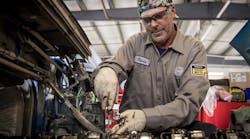In order to run an effective maintenance program you need properly trained technicians. Making sure they are properly trained has the added bonus of helping with technician retention among techs who want to grow and expand their knowledge base.
Let’s look at an example of how training pays off. There is a truck in your shop with an MIL (malfunction indicator lamp) on due to a NOx sensor related fault. An untrained technician will immediately see the fault and assume the sensor is bad. The reality is there could be many different issues. If an untrained technician replaces the sensor, or multiple sensors, without further diagnostics, that could easily cost $800 or more. It could also lead to very costly tow bills and more downtime in the near future since the root problem was not corrected.
On the other hand, a trained technician has a far better understanding of the system and will be better able to diagnose the problem correctly so more accurate repairs can be made. In this case, it could be something as simple as an engine calibration.
I think we can all agree that training is important, so the next question is what is the proper way to train?
Effective training starts with creating an objective and then ensuring everyone involved in the training understands it. When technicians know the purpose of the training they can stay focused on the goal.
Training should always be taught in steps. Starting with the basics is critical. There are too many times that technicians attend very advanced training without understanding what they are learning.
For instance, if the objective is for the technician to have a better understanding of advanced electrical diagnostics, then they have to understand basic electrical because even some of the most simple sensor operations work by the basic principles of electrical and resistance. Make sure the training is presented in a way that is understandable to the technicians.
An example of that could be teaching gear ratios by explaining that bigger ratios are like bigger people: the bigger the numerical ratio, the more pulling torque it will have, yet it will have very slow top end speed. On the other hand, a smaller numerical ratio will be like a smaller person: much faster top speed but far less pulling torque. Now anything with gears, like transmissions and differentials, can be explained more easily because the basics are understood. This step also needs to include explaining the names, locations, and purpose of the components or the systems being taught.
After the basics are understood, the next step is training the technicians on the principles of operations. Visual aids are extremely critical with this type of training because a lot of technicians are visual learners. You absolutely cannot diagnose today’s advanced system without understanding how it works.
When this part of training has been completed, a technician will understand how a system flows, which systems work together, how science and chemistry might play a role in operations, and how the system can malfunction. Using the aftertreatment system as an example, following training technicians should have a clear understanding of how and why heat is created, and how other systems, like fuel injection and the turbo, play a role in the operation of the aftertreatment system.
The final stage of training consists of putting the information together, explaining the purpose of tools and ensuring that the technicians can use what they learned. Hands-on training is most effective with extremely advanced and complicated systems. Once the technicians have successfully completed the task, it will help motivate them to use the knowledge they gained in the future and take away a lot of the fear of not knowing what they are doing.
Properly trained technicians will save a fleet money in the future. And well-trained technicians are more likely to stay in your employ because good techs are always looking to grow and expand their knowledge base because of the rapid pace at which technology is evolving. If technicians don’t receive training on a continual basis they will not be able to perform their jobs properly. Since most technicians take pride in their work and want to fix it right the first time, they will become frustrated if you do not help them keep their skills up to date and may leave for a fleet that will.



